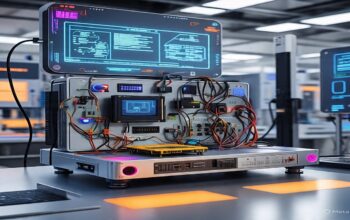People have adapted wearable devices as the most popular IoT systems for personal use due to their affordability and ease of use. The article that follows talks about the 10 most innovative wearable IoT devices with which everybody needs to be familiarized in 2025.
Covered Contents
ToggleSmart Jewelry:
jewelry can do much more than just be an ornament. Apart from fitness tracking and smartwatches, jewelry can even monitor users’ activity by harnessing the power of IoT. There is already IoT-enabled jewelry available in the market that can be worn in various forms like bracelets, clips, or necklaces. For example, a beautiful pendant that could be powered by IoT can perform the duty of a sleep monitoring device or an activity tracker. Smart jewelry can also help to detect the level of stress that a person has and recommends relaxing the mind on mobile. In conclusion, wearable IoT devices are not restricted to the examples mentioned earlier, but through smart working from these devices, it may be well estimated that IoT will be very thought-provoking in the future. These wearable IoT devices will move forward and will make human life much easier.
Fitness Tracker:
The lives of people are getting busier day by day, and in this hustle, people overlook their fitness and health. However, with the help of the latest wearable IoT fitness bands, people can now keep track of their daily fitness activities. The fitness tracker monitors the calories burned, weight gained, distance traveled, blood pressure, and heart rate. Some fitness trackers can even monitor sleep and indicate whether the user has an adequate level of sleep every day. The device also suggests healthy remedies. With wearable IoT devices, people do not need to worry about their fitness.
Smart Clothing:
There is hardly any industry left where IoT does not have its traces. It is surprising to know that IoT has enabled clothing as well to embrace smart technology. Smart clothing is a wearable technology that provides all body- or health-related information to the user. Smart clothing is the fusion of fashion and technology. Smart clothes have many sensors attached to them that track the physical condition of the wearer with accuracy. It can detect temperature, respiration rate, heart rate, and other health-related information. These can be used widely for military purposes.
Smart Ring
In real life, the mass public always fails with their car keys, home keys, and metro cards, as well as credit cards in one hand at all times, and indeed concern is shown if any of them may slip out. Smart Ring could be powered by NFC, as it could solve all the issues mentioned above. For sight, a smart ring could look like a ring used in life, but inside, the entire technology sits on one finger. The ring has network connectivity, and it is embedded with sensors that are linked to the software through which the data can be shared or exchanged. The ring also includes intelligent technologies, such as door lock, net file share, soft voice, link share, business card share, and program lock. With only a simple finger approach, people can now pay their bills, use metro ticketing, and unlock their car and home doors if they are NFC enabled.
Smart Glasses:
The advent of wearable computer glasses, or smart glasses, is extremely surprising and still seems like the thing of the future. But now smart glass with smart functionalities is becoming a reality. Smart glass is highly advanced wearable technology that can add useful information alongside an object or a view that the wearer sees. These are widely used for security and healthcare purposes. For instance, police can use their smart glasses to identify the crime suspect by using the facial recognition function. In healthcare, these glasses are used for telemedicine, automatic patient data entry, hands-free video or photo documentation, and rapid diagnostics. Further, AR smart glasses have also been introduced to enhance the eCommerce or retailing experience of a customer. The glasses can track in-store promotions and also do a price or quality comparison for purchase. These glasses can also be used for navigation, indoor or outdoor sports activities, and hands-free cooking assistance.
Smart Belt:
Wearable IoT devices have also penetrated the apparel and fashion accessories industries; for example, the introduction of the smart belt is a perfect example of smart clothing. The smart belt not only gives a good look but also saves the user from falling risks. Through algorithms and embedded sensors, the smart belt can easily predict the risk of falls from abnormal gait patterns. The smart belt measures the gait patterns, for instance, the symmetry and speed, and immediately alerts the user if any potential fall risk is identified. Also, a mobile phone application is integrated with the intelligent belt that can visualize possible weight gain and can track the users’ activities, for example, sitting habits, calories, and step count.
Gaming Armbands:
The majority of gaming devices allow the user to make their gaming adventure even more involving, exciting, and physical. The technology of gaming simulation is not new, as the VR/AR headsets have already given the ability to the gamer to be a part of the game. However, more innovative wearable IoT devices are coming into the market. For instance, the smart armband enables the gamer to control the gaming aspects just by their hand gesture. This armband’s built-in sensors detect arm, muscle, and finger movement and replicate it in the virtual character in the game. This IoT-enabled technology is a step above gaming peripherals and vibrating controllers. The focus of wearable IoT devices for gaming will always be on improving the gaming experience for the users.
Smart shoes:
IoT and other advanced technology are changing reality, and everything that would seem to be something futuristic or unreal is now being used by human beings. One of the latest trends of the future is smart shoes. False-seated shoes for players or individuals can cause an unsteady state and a balance problem, which can cause immense pain. Smart shoes embedded with IoT sensors can easily overcome the above-mentioned problem. Sensors keep track of blood pressure and adjust the shoe accordingly. So even though physical activities cause swelling of the feet, the player still feels well. The smart shoe also tracks calories, steps, posture, fatigue, and other health parameters to prevent injuries. The smart shoe is connected to the mobile phone application through Bluetooth for real-time and personalized coaching.
Smart Gloves:
During the last 40 years, smart gloves have remained under development to support human-computer interaction based on the movements of a finger or hand. Smart gloves also include a wide range of IoT sensors; these gloves can be put to use in various other ways, depending on work. Majorly, smart gloves have been designed to enable users to manipulate virtual objects by touching them more directly and intuitively. For instance, controlling objects in games, managing home appliances with a snap of a finger, or, most importantly, it can be used to bridge the gap between the normal masses and the people belonging to a deaf or dumb community. By converting sign language into text or speech with the help of smart gloves, people who are deaf and dumb can easily communicate with others. Although this wearable IoT device has not yet become a norm, it will become one soon.
GPS tracking band:
Parents are worried about the safety of their children when they are roaming in the park or going to school, as they cannot keep an eye on them every time. This is where GPS bands of trackers come in handy. This wearable IoT device has a GPS receiver. It is flexible, waterproof, lightweight, and harmless to health. A child can wear this GPS tracking band on the wrist. This helps the parents to keep track of their children and immediately get an alert on a mobile phone application whenever their child is in trouble. This device is also helpful to amnesia patients because they easily forget their addresses. The GPS tracking band can be attached to the pet, especially a pet dog or a cat, so that the owner may track his or her location when it gets lost.



6 thoughts on “10 Must-Have Wearable IoT Devices for 2025”